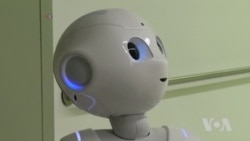Industrial robots started replacing humans long ago in tedious and dangerous jobs, such as welding thousands of identical parts for vehicles. Today, more sophisticated robots are capable of precisely lifting and moving huge loads, such as railway engines, or sorting merchandise for rapid shipment from massive warehouses.
Skeptics say robots’ future as autonomous drivers might be a bit murky, but they can handle parallel parking like a pro. A robot valet named Geta can easily maneuver a car into a tight space that many drivers would bypass as too risky.
Marco Wu, head of Yeefung Automation Technology, the Chinese firm that developed Geta, says the robot can safely park a car in about two minutes.
"The robot can go everywhere without tracks, which is free and versatile and will reform parking in the future," he said.
Geta looks like a platform on wheels. Directed by a laser guidance system, it slides under a car, lifts it up and rolls it into an available parking space before lowering it and rolling away. Wu says that, besides saving maneuvering time, Geta needs up to 40 percent less space when it positions a car, which could be crucial — especially in big cities.
Another more human-like robot recently began working as receptionist at a hospital in Ostend, Belgium. Pepper, built by Zora Bots, can speak 19 languages and analyze voice tones and facial expressions. Its job is to greet patients, provide basic information and show them to appropriate rooms. With a full battery, the robot can work for up to 20 hours.
Standing just over a meter high, Pepper is not considered intimidating to children, and it rolls along at a slow pace that allows even elderly patients to keep up. Developers say Pepper's main job is to make people feel better in a hospital setting.











